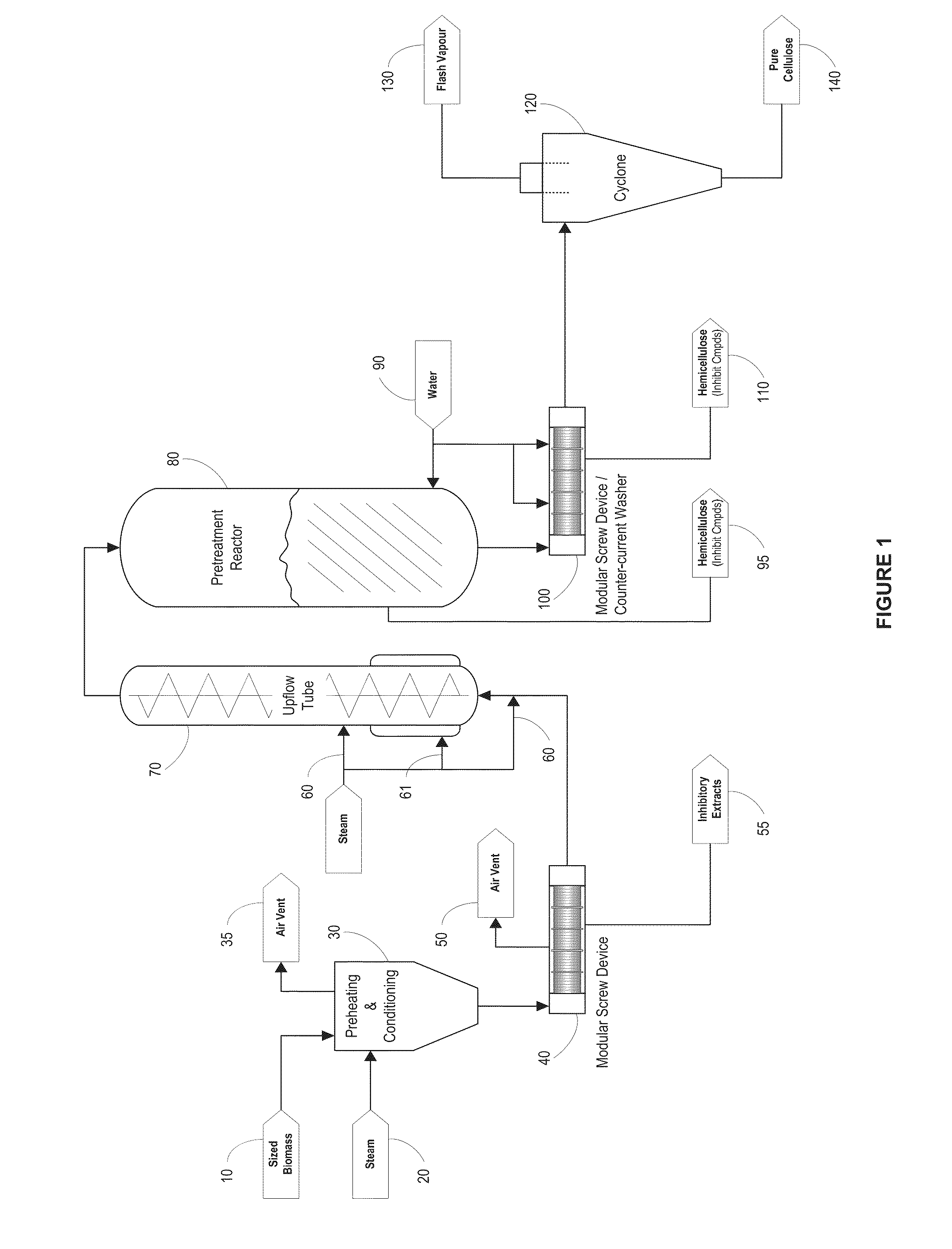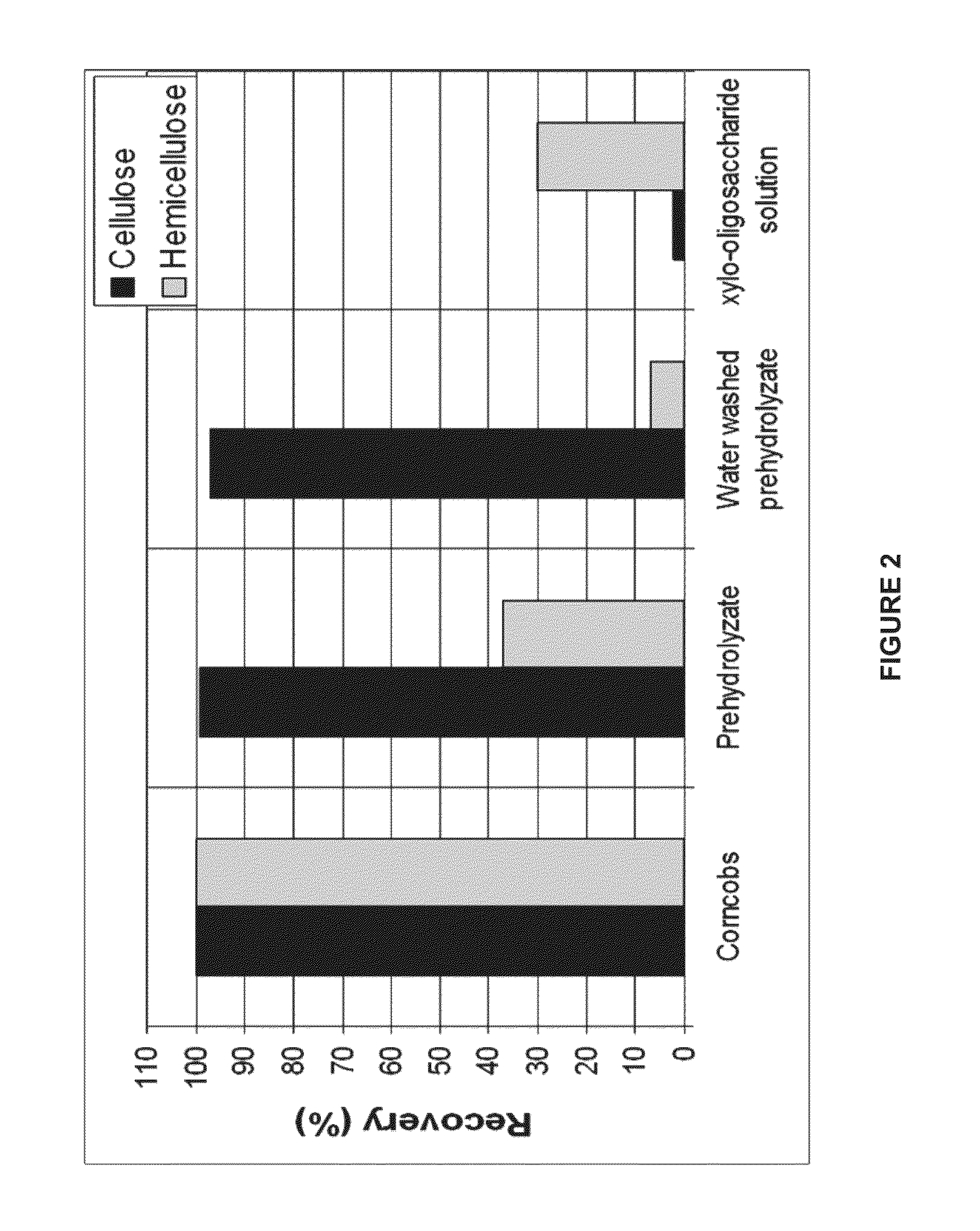Fractionation of lignocellulosic biomass for cellulosic ethanol and chemical production
a technology of cellulosic ethanol and lignocellulosic biomass, which is applied in the field of cellulosic ethanol production from lignocellulosic biomass, can solve the problems of increasing the level of hemicellulose breakdown and degradation products, outweighing the benefits of increasing hemicellulose breakdown and cellulose release, and improving the overall effect of health
- Summary
- Abstract
- Description
- Claims
- Application Information
AI Technical Summary
Benefits of technology
Problems solved by technology
Method used
Image
Examples
example 1
Autohydrolysis Pretreatment Process
[0073]In the following example, reference numbers refer to features of the pretreatment system and process streams, as shown in FIG. 1.
[0074]Continuous steam explosion pretreatment of lignocellulosic biomass is carried out in a steam explosion pretreatment system. In this example the biomass is corncobs.
[0075]Corncobs 10 are received, stored, cleaned, ground (0.5 to 1 cm3 particle size) and fed through a V shaped hopper and screw auger (not shown). The corncob moisture is adjusted to 50% DM.
[0076]Prepared corncobs are pre-conditioned by preheating them with live steam 20 at atmospheric pressure, in a holding bin or preheating and conditioning container 30 to a temperature of about 95° C. for about 10-60 minutes. Air and steam are vented through an air vent 35 from the preheating and conditioning container 30.
[0077]Preheated corncobs are compressed in a first modular screw to remove air 50 through an air vent and inhibitory extracts 5. The corncobs ...
example 2
High Pressure Pretreatment of Corncobs
[0094]Steam explosion pretreatment of corncobs was carried out in a steam explosion pretreatment system pressurized with saturated steam at a temperature of 205° C. No acid was added to the corncobs during the heating step. The corncob moisture was adjusted to 60% DM. The overall retention time of corncob pretreatment was 8 min e.g. 3 min in the up flow tube, 5 min in the pretreatment reactor at pH 3.8. Corncob acidification resulted from the release of acetic acid from hemicellulose breakdown.
[0095]Pretreated corncobs were water washed.
[0096]Cellulose extraction from corncobs was carried out at pilot scale with a percentage recovery of 98% (FIG. 5).
[0097]59% of the incoming hemicellulose was recovered after high pressure pretreatment of corncobs. 52% of incoming hemicellulose was collected into the xylo-oligosaccharides solution (FIG. 5). The resulting lignin free solution contained 89% sugars, including 66% of xylo-oligosaccharides (w / w) on a ...
example 3
Low Pressure Pretreatment of Corncobs
[0098]Steam explosion pretreatment of corncobs was carried out in a steam explosion pretreatment system pressurized with saturated steam at a temperature of 170° C. No acid was added to the corncobs during the heating step. The corncob moisture was adjusted to 50% DM. The overall retention time of corncobs pretreatment was 85 min e.g. 15 min in an up flow tube, 70 min in a pretreatment reactor at pH 3.8. Corncob acidification resulted from the release of acetic acid from hemicellulose breakdown.
[0099]Pretreated corncobs were water washed.
[0100]Cellulose extraction from corncobs was carried out at pilot scale with a percentage recovery of 98% (FIG. 6).
[0101]51% of incoming hemicellulose was recovered after low pressure pretreatment of corncobs. 43% of incoming hemicellulose was collected in the xylo-oligosaccharides solution (FIG. 6). The resulting lignin free solution contained 88% sugars, including 65% of xylo-oligosaccharides (w / w) on a dry mat...
PUM
| Property | Measurement | Unit |
|---|---|---|
| Fraction | aaaaa | aaaaa |
| Fraction | aaaaa | aaaaa |
| Fraction | aaaaa | aaaaa |
Abstract
Description
Claims
Application Information
 Login to View More
Login to View More - R&D
- Intellectual Property
- Life Sciences
- Materials
- Tech Scout
- Unparalleled Data Quality
- Higher Quality Content
- 60% Fewer Hallucinations
Browse by: Latest US Patents, China's latest patents, Technical Efficacy Thesaurus, Application Domain, Technology Topic, Popular Technical Reports.
© 2025 PatSnap. All rights reserved.Legal|Privacy policy|Modern Slavery Act Transparency Statement|Sitemap|About US| Contact US: help@patsnap.com



